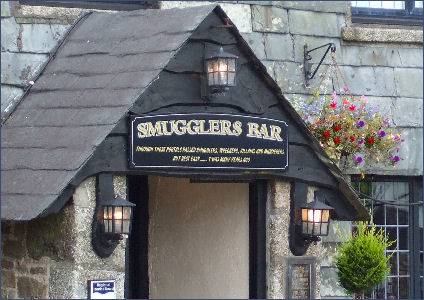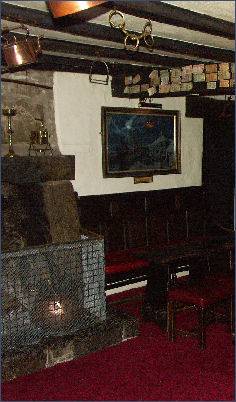Bolventor
OS Grid ref:- SX 184768
 The hamlet of Bolventor (Cornish: Bedhasbold) is situated at the heart of Bodmin Moor and lies just off the Bodmin to Launceston road.
The hamlet of Bolventor (Cornish: Bedhasbold) is situated at the heart of Bodmin Moor and lies just off the Bodmin to Launceston road.
The village's name is said to derive from the "Bold Venture", a reference to farming on such difficult moorland, but this is probably folk etymology, as "Bol-" is a common prefix in Cornish placenames. there are excellent views of the moor from Bolventor, including the main tors, Brown Willy and Rough Tor.
The village consists of a church and a few houses. The granite parish church is dedicated to The Holy Trinity, the building was consecrated on 3rd July 1848 and constructed in the Gothic style. The building had ceased to be used by the 1990's. The farm where the astronomer John Couch Adams was born is located nearby.
The authoress Daphne du Maurier, was a former resident of the hamlet and immortalised Bolventor when she chose it as the setting for her famous novel 'Jamaica Inn', featuring Cornish smugglers. Now Cornwall's most famous inn, it was once a former coaching house, an inn has occupied the main road through the village since 1547, the present building dates to 1750.
Jamaica Inn
 Modern visitors to the inn can relive the smugglers’ experience, as the inn boasts one of the finest and most extensive collections of smuggling artefacts in Britain, there is also a display of various items owned by Daphne du Maurier, including her writing desk and typewriter.
Modern visitors to the inn can relive the smugglers’ experience, as the inn boasts one of the finest and most extensive collections of smuggling artefacts in Britain, there is also a display of various items owned by Daphne du Maurier, including her writing desk and typewriter.
The Jamaica Inn was built in 1750 and was extended in 1778 when a coach house, stables and a tack room were added. The inn was to became a smugglers' stopping point, they are said used many secret routes to move around their contraband.
Gangs of wreckers operated on the Cornish coast in early nineteenth century. Cornwall has been very described as the "haven of smugglers"due to its "rocky coves, sheltered bays, tumultuous waves and wild and untenanted landscapes". The wreckers tricked ships to the coast line with the use of beacon lights, which they themselvess installed on the shores of the coas for that purpose. When the ships foundered on the rocky coast they were duly looted by the wreckers.
 The Jamaica Inn's past notoriety as a pirates' den was known to Daphne du Maurier three years prior to writing her famous book, when she had lived in the inn and drew on this experience experience she had penned her popular novel the 'Jamaica Inn', describing the nocturnal activities of a smuggling ring "portraying a hidden world as a place of tense excitement and claustrophobia of real peril and thrill.".
The Jamaica Inn's past notoriety as a pirates' den was known to Daphne du Maurier three years prior to writing her famous book, when she had lived in the inn and drew on this experience experience she had penned her popular novel the 'Jamaica Inn', describing the nocturnal activities of a smuggling ring "portraying a hidden world as a place of tense excitement and claustrophobia of real peril and thrill.".
It is widely assumed that the inn derives its name from the smugglers who illegally brought rum into England from Jamaica and stored it at the inn.The inn is, however, actually named for the connections of the influential important local Trelawney family, who were landowners, two members of the family served as Governors of Jamaica in the eighteenth century
The inn offers accommodation and serves excellent food. Rumoured to be haunted, the Jamaica Inn featured in an episode of the programme, Most Haunted, on 'Living' TV. Notable apparitions include a malevolent figure of a highwayman in a tri-cornered hat, a distressed young mother and her baby and the spirit of a young smuggler who is believed to have been murdered at the bar and who has been reported to be seen sitting on the wall in the courtyard.
The Museum of Smuggling is situated in the main coaching house. The museum holds a varied collection of smuggling artifacts that is depicted through the history of the Jamaica Inn and the inn's role in this trade for many years. The Cornish coast was the most popular location for smuggling of silks, tea, tobacco and brandy into England.
The museum contains various items including 'wanted' posters, one of which dates to 1798, a poster celebrating Lord Nelson's victory at the Battle of Trafalgar, pottery figures of smugglers and villains and a bag of '10 pounds of Jamaican ganja'. There is also a display in the room where Dapne du Maurier stayed which consists of various items owned by the author, including her writing desk and typewriter.
Pirates, Smugglers and Wreckers of Cornwall
A walk from Bolventor to King Arthur's Hall